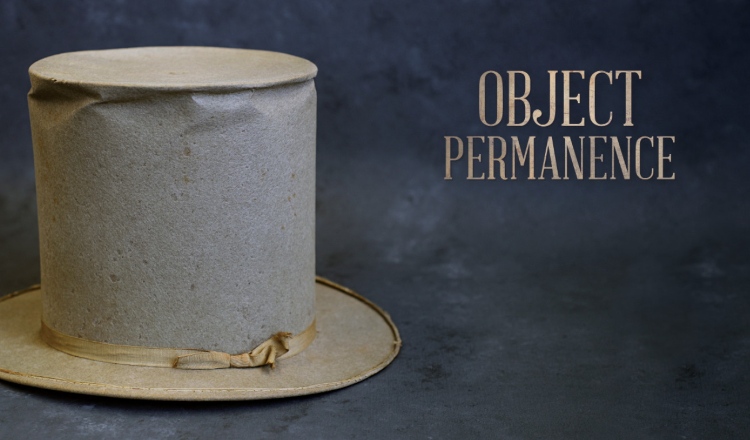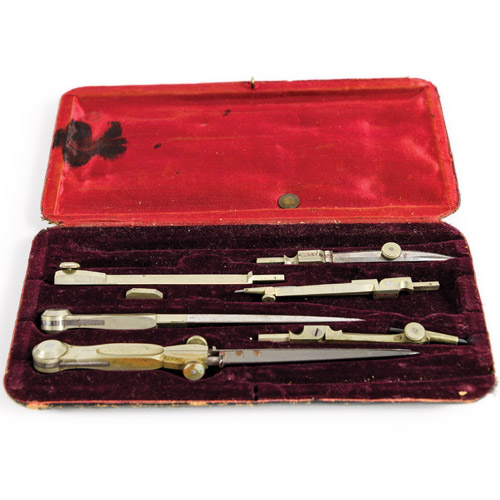
41. Edward Harper’s Drawing Tools
Any engineering student of the 19th century would own a set of drawing tools for mechanical drafting. This set belonged to Edward R. Harper of Goshen, Indiana, a member of the class of 1892. As a student, he was literary editor for the Exponent, art editor for the Debris, and president of the Irving Literary Society. The first student organization on campus, the society was devoted to the intellectual pursuit of literature and debate. Harper died of tuberculosis 16 days before graduation.

42. Embraer Phenom
In a single day, professional flight technology majors fly this twin-engine jet from campus to St. Louis, on to Dallas, and all the way back to West Lafayette! Student pilots log about 40 minutes in a simulator before flying the jet. The Phenom is also used to support university administration and their travel needs. Faculty, coaches, and other campus leaders use the plane to attend conferences or meetings, tour a company, or occasionally bring a guest to campus. Students who have completed the Phenom courses may fly as first officers alongside professional captains on these flights. Students have logged nearly 3,700 hours and 5,800 landings in the Phenom, cruising along in their classroom at 41,000 feet and 440 mph.
Watch the planes take off at the Purdue University Airport.
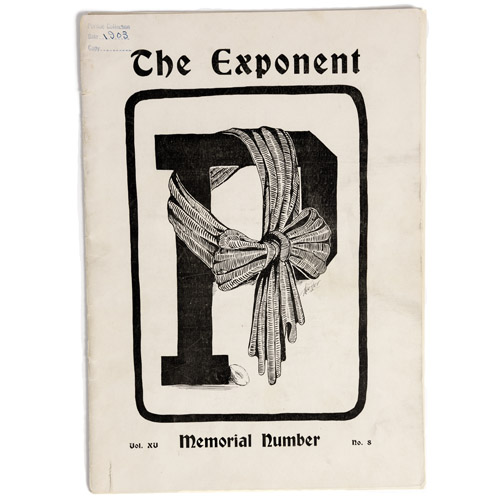
43. ‘Exponent’ Train Wreck Memorial Issue
On October 31, 1903, a misplaced message from a telegraph operator resulted in one of Purdue’s greatest tragedies. A train carrying the football team to a matchup against Indiana University collided with a coal train. Seventeen people died in the accident, including 11 players. The November 11, 1903, edition of the Exponent described how local alumni began fundraising for a memorial gymnasium in honor of the dead. “Every heart is bowed in sorrow and yet no life that witnessed the disaster will remain the same as before and we cannot but believe that all must be truer and better in consequence of the memory of those whose lives were sacrificed.” Now known as Felix Haas Hall, the building has 11 steps, a landing, and six more steps representing those who perished.
The railroad tracks have been removed from the site of the 1903 train wreck.
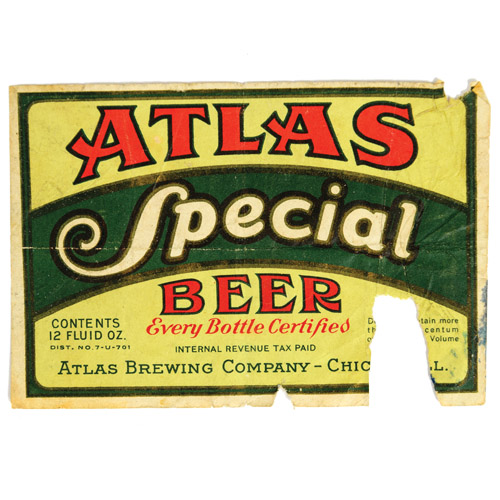
44. First Beer After Prohibition
Andrew Kolar (ME’35) was believed to be the first person legally served a bottle of beer in Lafayette following the repeal of Prohibition in 1933. He saved the label and later donated it to Purdue Archives. Kolar ordered the beer at Hook’s Drug Store in Lafayette. The law required that beer be served with food. Hook’s, like many drugstores at the time, kept an inventory of sandwiches at the ready. Once the beer was consumed, the uneaten sandwich would be removed and served again and again throughout the day.
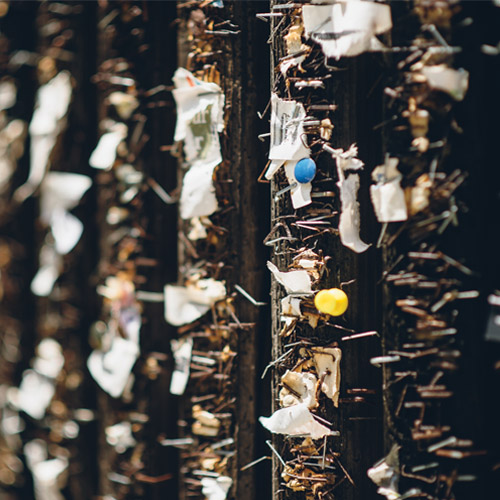
45. Flyer Kiosk
Campus life brims with activity. Just ask the wooden kiosks that have been blanketed with flyers for decades. After the various club and organization events conclude, the leaflets are removed, but the staples remain.
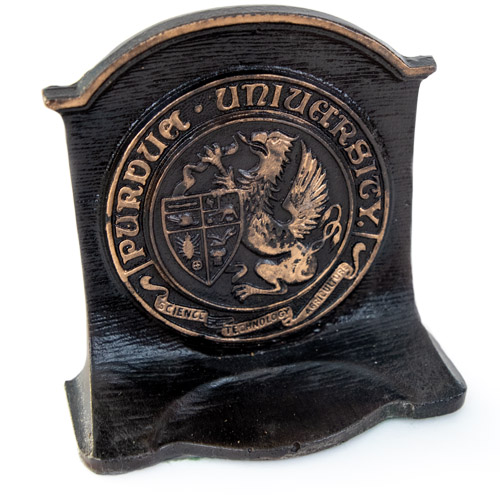
46. Foundry Class Book End
As a land-grant institution, Purdue was charged with creating a practical education in science, technology, and agriculture — as shown on the University seal on this bookend, circa 1910. The foundry-related skill of pouring liquid metal into molds was considered to be one of the fundamental, pragmatic skills required of graduates well equipped to enter the late 19th-century and early 20th-century workforce. Early students created bookends, paperweights, and other cast-iron objects. A project of this quality and complexity would have been the work of an upperclassman.
A foundry class book end is on display in the Rudolph Room at Dauch Alumni Center.
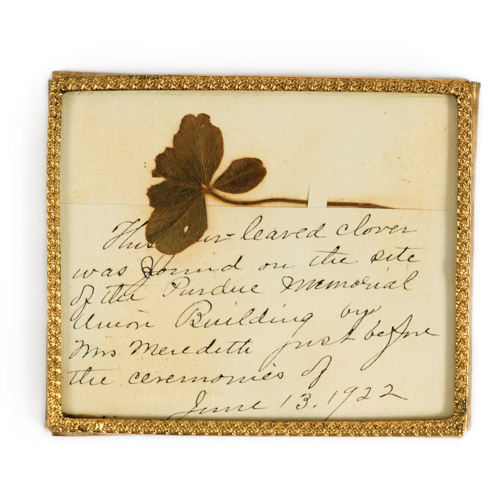
47. Four-Leaf Clover
Virginia Claypool Meredith spotted this four-leaf clover on June 13, 1922, just before the groundbreaking ceremonies of the Purdue Memorial Union; she served as chairwoman of the event. She was the first woman appointed to the board of trustees. A nationally known woman farmer, Meredith was dubbed Queen of American Agriculture and firmly believed that farming is a vocation suited for women, stating, “A cow makes as many — or more — pounds of butter when owned by a woman, as when owned by a man.”
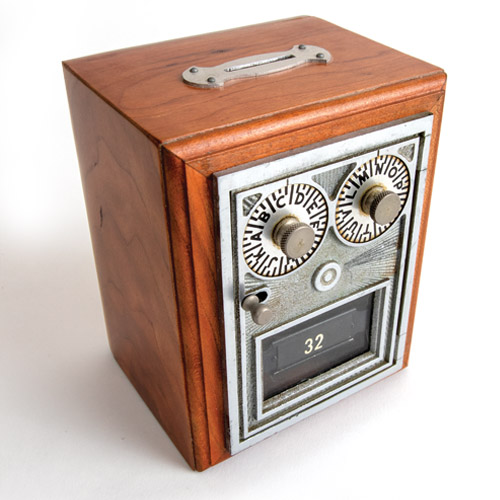
48. Fowler Courts Mailbox
Generations of Boilermakers accessed mailboxes like this while they lived in the residence halls. When Fowler Courts was demolished in 1993, its mailboxes were saved and repurposed into collectible coin banks.
The site where Fowler Courts once stood is now occupied by First Street Towers.

49. Game Bibs
A relatively recent addition to the collegian wardrobe, game-day bib overalls made their splash on campus when the Reamers began wearing them en masse during athletic events. Their popularity continues to increase, with more and more students donning striped bibs every home football game. Although the bibs are manufactured in a variety of school color combinations, the attire seems especially appropriate for an engineering school with a train mascot, hearkening back to the conductor overalls of yesteryear.
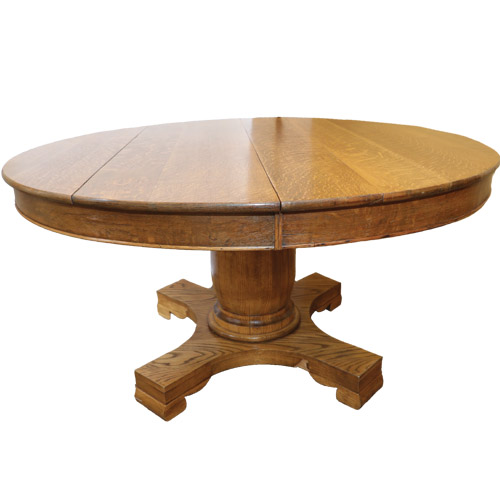
50. George Ade’s Table
This round oak table housed in Wood Hall reportedly came from Hazeldon, the home of George Ade (S’1887, HDR LA’26). Ade, at one time one of the most famous writers in the country, often focused on current events in his sharp, satirical humor.

